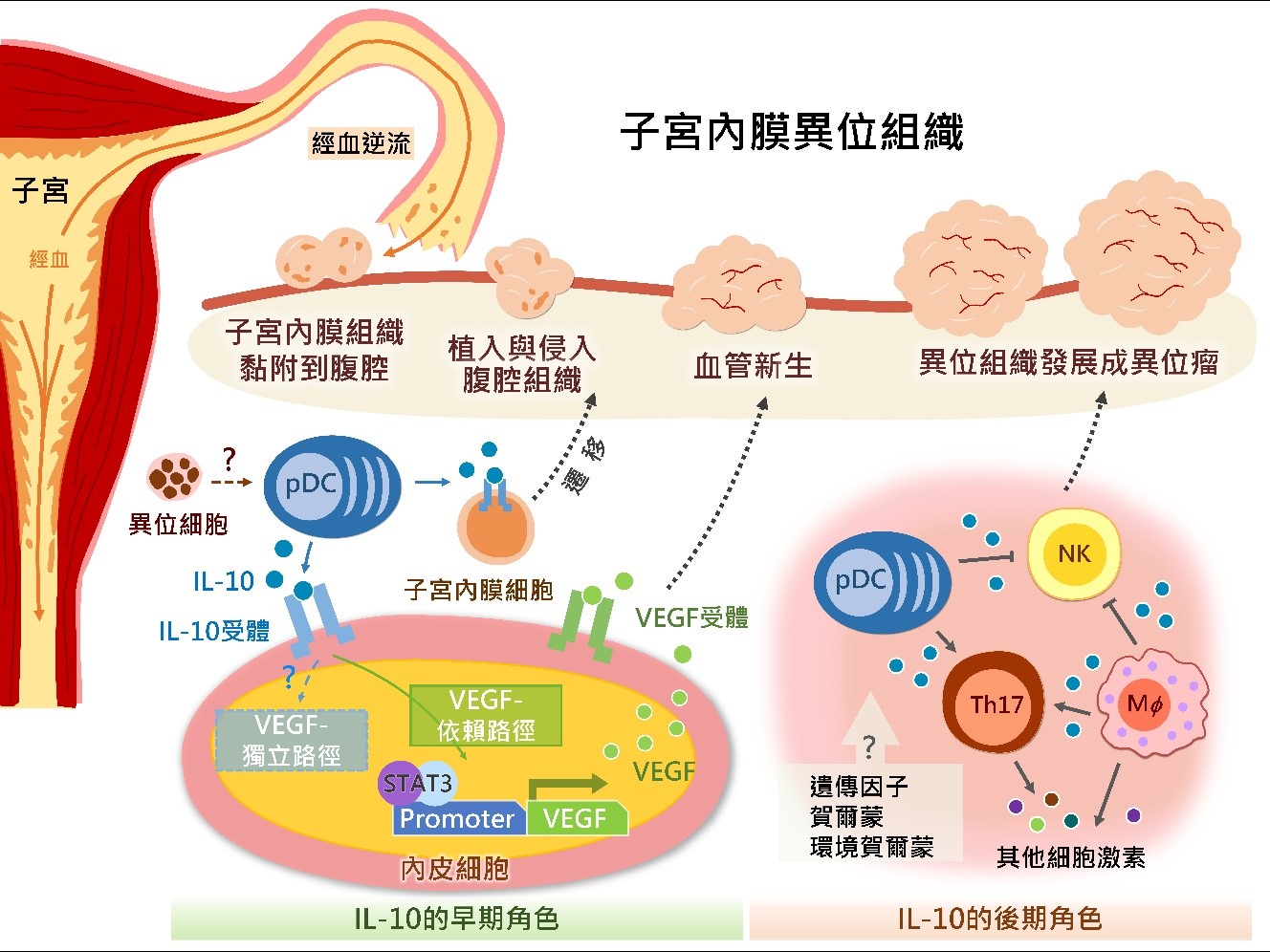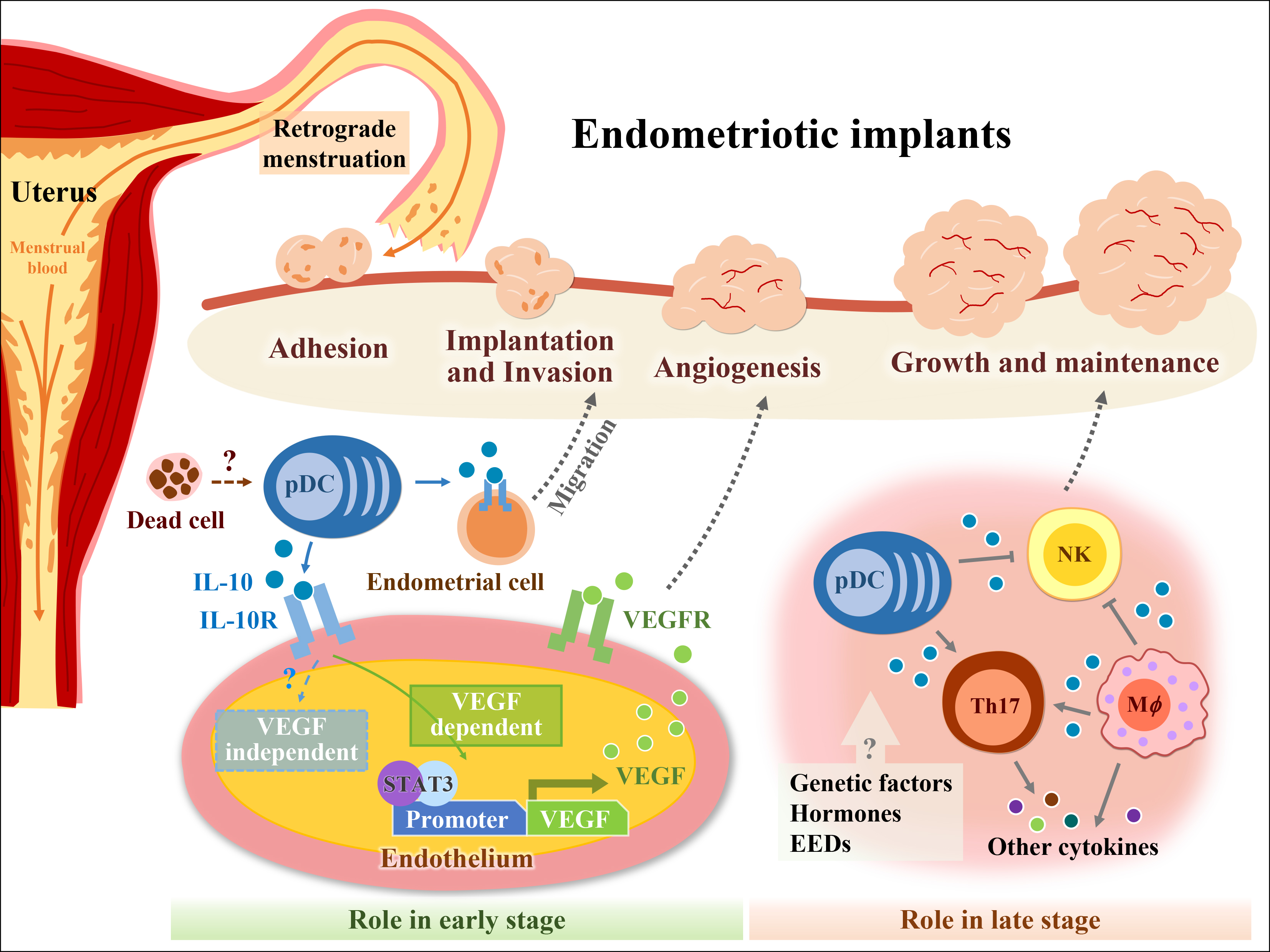找到子宮內膜異位症早期發展的關鍵細胞激素–IL-10的雙重角色
找到子宮內膜異位症早期發展的關鍵細胞激素–IL-10的雙重角色
[簡介]
子宮內膜異位症是惱人的婦科疾病,生育年齡的婦女約有6–10%的人患有此病,主要症狀是經痛、性交疼痛與不孕,治療後又很容易復發,是很不容易治癒的婦科疾病◦
[迷路的內膜組織]
這種百年無法解決的婦女疾病,成因到底為何呢?目前最被接受的說法是「經血逆流」理論,婦女每月剝落的子宮內膜組織,有部分可能會逆流回腹腔,此時體內免疫系統的白血球細胞會吞噬清除這些異位組織,這個清除過程會發生短暫且微弱的發炎反應,若這發炎反應能夠調控得當的話,就能順利清除逆流組織而又不產生副作用(強烈發炎),這樣這些異位組織就不會累積、黏附、與生長於腹腔中,變成子宮內膜異位的良性腫瘤,每個月報到的「好朋友」也就不會造成女性的生理與心理負擔。
[失調的發炎反應]
那什麼原因會使清除異位組織的發炎反應失調呢?高醫大孫昭玲副教授研究團隊發現「抗發炎因子IL-10」的濃度過高,可能是重要的原因之一;IL-10是各種發炎反應都會伴隨產生的細胞激素(蛋白質),當腹腔中的白血球在清除迷路的內膜組織時,也會產生適量的IL-10,功能是讓發炎不至於太強烈而傷害自己組織,但是如果IL-10量太高,反而會抑制白血球的吞噬功能而阻礙異位組織的清除,而高醫研究團隊利用小鼠模式與斑馬魚模式,發現IL-10居然還能促進血管的新生成,新生血管會讓幸運躲過攻擊的內膜組織生長於腹腔中,四處流竄與沾黏,最終變成子宮內膜異位瘤,成為婦女生活中的夢靨◦
[IL-10的雙重角色]
異位內膜組織中IL-10量太高,不僅阻礙了異位細胞清除,又促進血管新生成支持異位組織生長,那甚麼白血球會產生IL-10呢? 高醫研究團隊利用小鼠動物模式發現可能類漿性樹突細胞(plasmacytoid dendritic cell)在早期子宮內膜異位瘤生長時,就會產生IL-10支持子宮內膜異位瘤的生長與血管新生,而且在病人第四期子宮內膜異位瘤的病理組織中,也確實發現分泌IL-10的類漿性樹突細胞的蹤跡。
[結語]
我們正進行深入研究釐清類漿性樹突細胞在這疾病早期發展時的角色,還有哪些環境汙染物會影響免疫細胞產生IL-10的能力,希望將來能針對這複雜疾病提供預防與新的治療方法。
圖形摘要

圖說:月經週期時部分子宮內膜組織會逆流回腹腔,內膜組織內的免疫細胞–類漿性樹突細胞(pDC)可能在清除異位細胞時產生IL-10,若IL-10產量太高,會促進子宮內膜細胞遷移與血管新生,這可能奠定了早期異位瘤的發展,異位瘤長大後就有多種免疫細胞也會產生IL-10,而過多的IL-10使得疾病惡化快速,進入後期的發展,病人多在此時出現症狀並就醫治療。(本圖修改自Suen et al. J Pathol. 2019 Dec;249(4):485-497.)
本校主要研究者之簡介:
1.高醫大醫研所孫昭玲副教授為本研究第一作者,研究領域為先天免疫細胞在過敏性氣喘的調控角色,近年也探究慢性發炎促進子宮內膜異位瘤癌化的免疫機制◦
2.高醫大醫研所蔡英美教授為本研究責任作者,不只為高醫婦產科主治醫師,專長生殖醫學,也長期從事內膜異位症機制研究。
3.高醫大生化學科侯自銓教授為本研究共同責任作者,專攻泌尿腫瘤與血管新生機制研究。
研究聯繫Email:jlsuen@kmu.edu.tw
期刊出處: J Pathol. 2019 Dec;249(4):485-497. doi: 10.1002/path.5339.
期刊線上參閱網址:https://pubmed.ncbi.nlm.nih.gov/31418859/
Popular Science Format in Academic and Research Column
Popular Science Format in Academic and Research Column
[Introduction]
Endometriosis is a chronic inflammation-associated and common benign gynecological disorder. It affects 6–10% of women of reproductive age with syndromes, including dysmenorrhea, dyspareunia, and infertility. Because endometriosis recurrence following conservative surgery is relatively high, it substantially affects patients’ daily activities.
[Lost way of endometrial tissue]
What is the pathogenesis of endometriosis? The wildly accepted hypothesis nowadays is the “retrograde menstruation/transplantation theory. The endometrial tissue shed during the menstrual cycle flow from the uterus into the peritoneal cavity. The retrograded cells or tissue are cleared by white blood cells. During this process, it would locally happen mild and transient inflammation in peritoneal cavity. If the process between clearance and inflammation keeps balance, the ectopic endometrial tissue can be effectively cleared and the inflammation would not damage the tissue in peritoneal cavity. Therefore, the lost-way endometrial tissue would not become endometriotic tumor and disturb daily activity in women of reproductive age.
[Dysregulated inflammation]
What might disturb the balance between clearance and inflammation when retrograde tissue loses its way into peritoneal cavity? The research team led by Dr. Jau-Ling Suen at Kaohsiung Medical University discovered that the high local activity of anti-inflammatory cytokine IL-10 may promote the growth of the endometriotic tissue. It has been demonstrated that IL-10 can control unwanted inflammation to avoid tissue damage; however, high activity or level of IL-10 may inhibit the functions of white blood cells and diminish the clearance of ectopic tissue. In addition, Dr. Suen and her colleges discovered that IL-10 can promote angiogenesis through IL-10R signaling in vitro and in vivo, including a murine model as well as a zebra fish model. Thus, the IL-10-mediated angiogenesis may promote the growth of endometriotic lesions through enhancing angiogenesis during the early stage of endometriosis.
[The dual activity of IL-10]
These findings discovered by Dr. Suen’s team suggest that the dual functions of IL-10 with respect to suppressing immunity against unwanted cells and promoting angiogenesis in the microenvironment may substantially contribute to the development of endometriosis. The next question is which immune cell type can secrete IL-10 in the microenvironment, particularly during the early stage of disease? Using a surgery-induced endometriosis murine model, Dr. Suen’s team demonstrated that local plasmacytoid dendritic cell (pDC), a key innate cell type in viral immunity, can secrete IL-10 to enhance angiogenesis in and promote growth of endometriotic lesions. In addition, IL-10–secreting pDCs have been found in the human endometrioma tissues, in which higher percentages of cells express IL-10 receptor and angiogenic marker CD31 compared with the corresponding normal counterparts.
[Conclusion]
We continue to put effort in elucidating the pathogenic role of IL-10–secreting pDCs and developing strategy targeting the IL-10–IL-10 receptor pathway in the endometriotic milieu.
Graphical Abstract

Figure. The cartoon shows the effect and immune cell sources of IL-10 during the early and late stages of endometriosis. During the menstrual cycle and the early stage of endometriosis, retrograded endometrial cells or tissue enter peritoneal cavity. Lesion plasmacytoid dendritic cells (pDCs) may produce IL-10 in response to unwanted cells. Local IL-10 further promotes lesion growth by either suppressing anti-ectopic fragment immunity or stimulating angiogenesis. During the late stage of disease, the complex interaction among genetic factors, endogenous hormones, environmental endocrine disruptors (EEDs), and impaired immune surveillance leads to chronic inflammation. In the context of chronic inflammation in the peritoneal cavity, other immune cells can secrete IL-10 and other mediators to further promote the growth and maintenance of ectopic implants. [The figure is cited from Suen et al. 2019. (J Pathol. 2019 Dec;249(4):485-497)]
Main researcher Intro.
1.Dr. Jau-Ling Suen, the first author, at Kaohsiung Medical University study the role of innate immune cells in the pathogenesis of allergic asthma and endometriosis.
2.Dr. Eing-Mei Tsai, the corresponding author, a gynecologist and reproductive endocrinologist, at Kaohsiung Medical University Hospital. She has devoted in the mechanistic study in endometriosis.
3.Dr. Tzyh-Chyuan Hour, the equally contributed corresponding author, at Kaohsiung Medical University focus on the mechanistic study in prostate cancer and angiogenesis.
Author Email
jlsuen@kmu.edu.tw
Paper cited from: J Pathol. 2019 Dec;249(4):485-497. doi: 10.1002/path.5339.
Paper online website: https://pubmed.ncbi.nlm.nih.gov/31418859/


